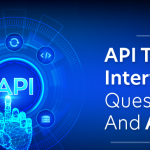In the realm of web development and communication, REST (Representational State Transfer) has emerged as a dominant architectural style. Two terms often used interchangeably are REST API and RESTful Web Services. However, they aren’t synonymous. In this comprehensive guide, we’ll delve into the distinctions between REST API and RESTful Web Services, exploring their features, use cases, and helping you navigate the dynamic landscape of modern web development.
Table of Contents
ToggleUnderstanding REST API
REST API Overview:
A REST API (Application Programming Interface) is a set of rules and conventions that facilitates communication between different software systems. It defines the methods and structures for building and interacting with web services. REST APIs enable developers to access the functionality of a remote system over the web.
Key Features of REST API:
- Statelessness: Each request from a client to a server contains all the information needed to understand and fulfill the request.
- Uniform Interface: Defines a standard set of conventions for interactions, including resource representation and URI structure.
- HTTP Methods: Utilizes standard HTTP methods like GET, POST, PUT, DELETE for operations.
- Data Formats: Commonly uses JSON or XML for data representation.
Use Cases for REST API:
- Mobile App Integration: Facilitates communication between mobile apps and servers.
- Third-Party Integrations: Enables integration with external services and platforms.
https://informationarray.com/2024/01/03/unveiling-the-metrics-battle-influxdb-vs-prometheus/
Unraveling RESTful Web Services
RESTful Web Services Overview:
RESTful Web Services adhere to the principles of REST architecture. They provide a standardized way of building and deploying web services that are scalable, stateless, and easily maintainable. RESTful services focus on resources, statelessness, and a uniform interface.
Key Features of RESTful Web Services:
- Resources: Entities that can be identified and manipulated, typically exposed through URIs.
- HTTP Methods: Utilizes standard HTTP methods for operations on resources.
- Representation: Resources are represented in a standard format like JSON or XML.
- Statelessness: Each request from a client to a server is independent and self-contained.
Use Cases for RESTful Web Services:
- APIs for Web Applications: Building APIs that power web applications.
- Microservices Architecture: Integrating microservices in a scalable and loosely-coupled manner.
Differences Between REST API and RESTful Web Services
1. Level of Adherence to REST Principles:
- REST API: May not strictly adhere to all REST principles and could incorporate custom conventions.
- RESTful Web Services: Strictly adheres to REST principles, emphasizing resources, statelessness, and a uniform interface.
2. URI Structure:
- REST API: URI structure may not follow strict RESTful conventions.
- RESTful Web Services: Adheres to RESTful URI patterns, emphasizing resource identification and manipulation.
3. Use of HTTP Methods:
- REST API: May use a variety of HTTP methods without strict adherence to standard CRUD operations.
- RESTful Web Services: Primarily uses standard HTTP methods (GET, POST, PUT, DELETE) in a CRUD-like manner.
4. Statelessness:
- REST API: May or may not strictly enforce statelessness.
- RESTful Web Services: Strictly adheres to the statelessness principle, with each request being independent.
https://informationarray.com/2024/01/02/how-do-i-add-extensions-to-quarkus-cli/
How to Choose Between REST API and RESTful Web Services
1. Project Requirements:
Consider the specific requirements of your project. If strict adherence to REST principles is crucial, RESTful Web Services might be the preferred choice.
2. Level of Control:
REST API provides more flexibility, allowing for custom conventions. If you need more control over the API design, REST API might be suitable.
3. Compatibility:
Consider the compatibility of the API with existing systems. If interoperability and adherence to standard practices are essential, RESTful Web Services may be preferred.
External Resources and FAQs
External Links:
FAQs:
Q1: Can a RESTful Web Service also be a REST API?
- A1: Yes, a RESTful Web Service adheres to REST principles and can be considered a type of REST API.
Q2: What data formats are commonly used in RESTful services?
- A2: JSON and XML are the most common data formats used in RESTful services.
Q3: Can a REST API use SOAP-based protocols?
- A3: While possible, it deviates from REST principles. REST APIs typically use HTTP and are stateless.
Q4: Is RESTful the same as REST?
- A4: RESTful refers to systems or services that adhere strictly to REST principles, while REST is a broader architectural style.
Conclusion: Navigating the RESTful Terrain
In conclusion, understanding the nuances between REST API and RESTful Web Services empowers developers to make informed decisions based on project requirements, principles, and compatibility. Whether opting for the flexibility of a REST API or the strict adherence to REST principles in RESTful Web Services, the choice depends on the goals, constraints, and specifics of the development project. By navigating this dynamic terrain, developers can leverage the power of REST to build scalable, interoperable, and stateless web services.








